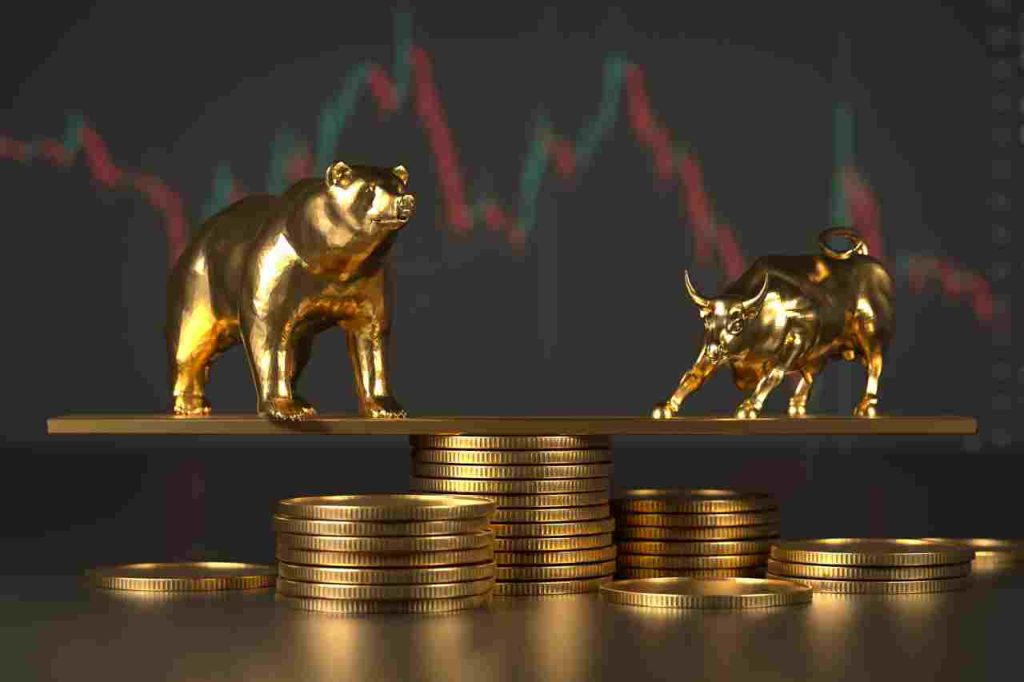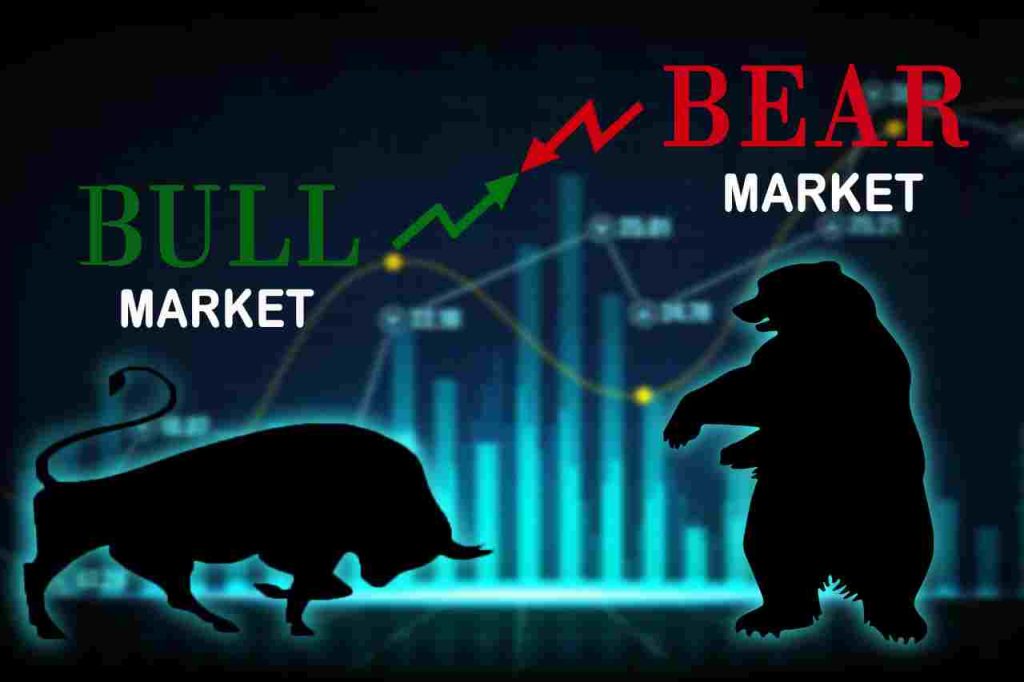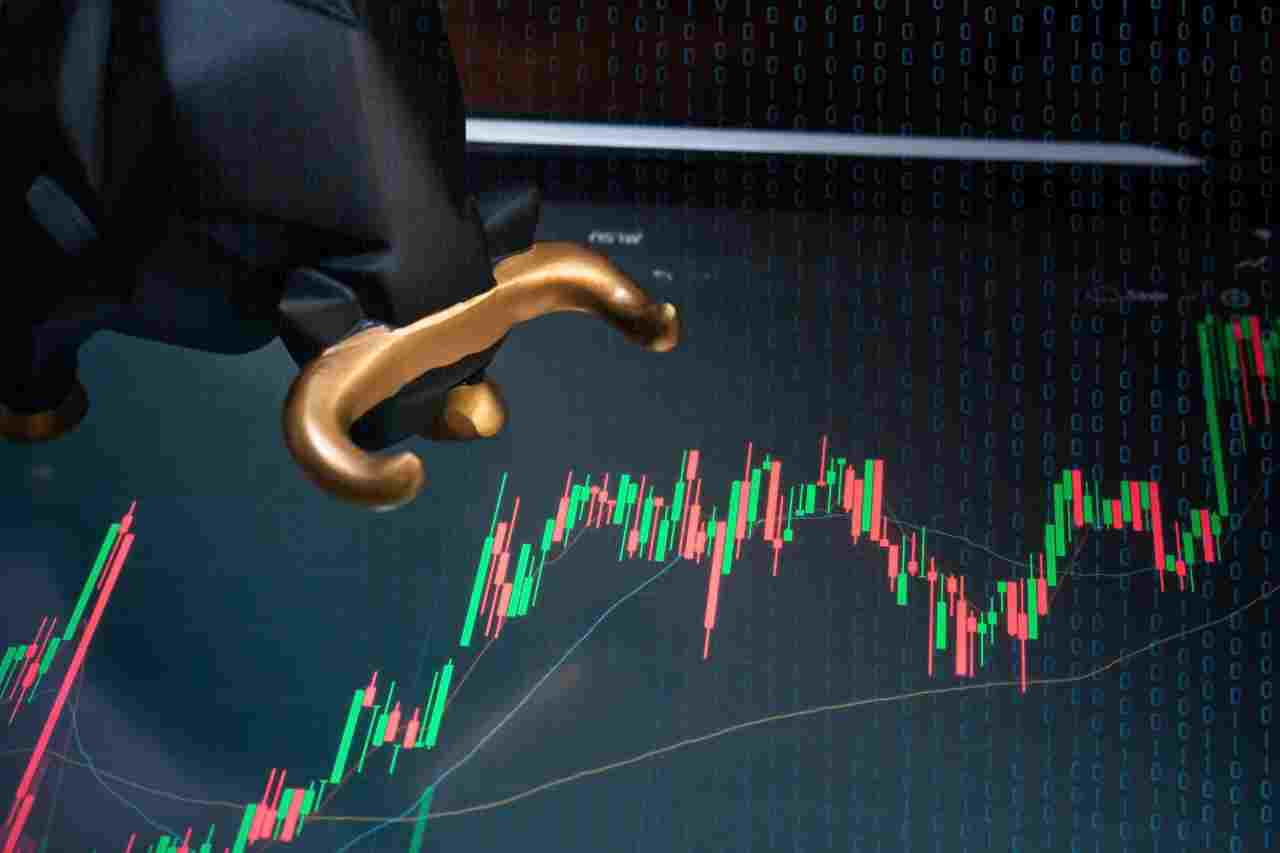Table of Contents
Bull and bear markets are standard terms in the world of investing and finance.
Understanding these two concepts is essential for any investor, as they can have a significant impact on investment decisions and portfolio.
We shall give an outline of in this blog bull and bear markets, their characteristics, causes, and examples.
We will also discuss the differences between the two and provide some investment strategies for navigating them.
By the end of this blog, you will have a better understanding of bull and bear markets and be better equipped to make informed investment decisions.
Bull Market
Definition of Bull Market
A bull market is a market condition where stock prices rise consistently over a prolonged period.
It is characterized by a strong investor confidence, optimism, and expectations of continued price appreciation.
Bull markets are typically associated with a growing economy, low unemployment, and high consumer confidence.

Features of a Bull Market
A bull market is one that has increasing stock values. strong investor confidence, and a growing economy. Some of the critical characteristics of a bull market include:
Increasing stock prices: In a bull market, stock prices are generally rising, and investors are optimistic about the future prospects of the market.
Strong investor confidence: Bull markets are characterized by strong investor confidence, with investors generally feeling optimistic about the market’s direction.
Low unemployment: During a bull market, the economy typically grows, and unemployment rates are low, which can further bolster investor confidence.
High consumer confidence: Consumer confidence tends to be increased during bull markets, with people feeling optimistic about their financial prospects and more willing to spend money.
Increased trading volume: In a bull market, there tends to be increased trading volume as investors look to take advantage of rising prices.
Risk-taking behavior: Bull markets can also be characterized by more risk-taking behavior among investors, as people may be willing to take on more risk in pursuit of higher returns.
Causes of Bull Market
Bull markets can be caused by a variety of factors, including:
Economic growth: When the economy is growing and expanding, businesses tend to do well, and this can lead to higher corporate profits, which in turn can drive up stock prices.
Low interest rates: Low interest rates can make borrowing cheaper and more accessible for both individuals and businesses, which can lead to increased investment and economic growth.

Strong corporate earnings: Strong earnings growth can signal a healthy and growing economy, and can drive investor confidence and demand for stocks.
Positive sentiment and investor confidence: Positive news and sentiment about the economy, politics, or other factors can also drive investor confidence and demand for stocks.
Fiscal and monetary policy: Policies that stimulate the economy, such as government stimulus packages or monetary policy actions by central banks, can also contribute to a bull market.
Technological advancements: Advances in technology can drive innovation and productivity, leading to economic growth and higher stock prices in specific sectors.
Examples of Bull Market
There have been several notable examples of bull markets throughout history, including:
The 1990s Tech Boom: The 1990s saw a significant bull market driven by the growth of the technology sector. The development of the internet and other technological innovations fueled investor demand for tech stocks, leading to price surges.
The 1980s Reagan Bull Market: The 1980s were characterized by a strong bull market that was fueled in part by the pro-business policies of the Reagan administration.
Tax cuts, deregulation, and other measures aimed at stimulating economic growth helped to drive up stock prices.
Thetime after World War II is known as the “Post-War Boom.” was characterized by a significant bull market lasting over two decades.

The post-war boom was driven by a combination of factors, including a growing economy, increased consumer spending, and the development of new industries.
The Trump Rally: Following the election of President Trump in 2016, the stock market experienced a significant bull market.
The rally was driven in part by anticipation of pro-business policies such as tax cuts and deregulation.
Bear Market
Definition of Bear Market
When the market is in a bear market, stock prices fall consistently over a prolonged period.
It is characterized by low investor confidence, pessimism, and expectations of continued price decline.
Bear markets are typically associated with a slowing economy, high unemployment, and low consumer confidence.
Characteristics of Bear Market
Bear markets are characterized by falling stock prices, weak investor confidence, and a slowing economy.
Some of the critical characteristics of a bear market include:
Decreasing stock prices: In a bear market, stock prices are generally Investors may lose confidence in the market’s prospects going forward since prices are declining.
Weak investor confidence: Bear markets are characterized by fragile investor confidence, with investors feeling uncertain and concerned about the market’s direction.

High unemployment: During a bear market, the economy is typically contracting, and unemployment rates are high, which can further erode investor confidence.
Low consumer confidence: Consumer confidence tends to decrease during bear markets, with people feeling uncertain about their financial prospects and less willing to spend money.
Decreased trading volume: In a bear market, there tends to be reduced trading volume as investors may be more cautious and less willing to take on risk.
Defensive behavior: Bear markets can also be characterized by more investors may be acting defensively since they may be more concerned with protecting their capital.and less willing to take risks.
Causes of Bear Market
Bear markets can be caused by a variety of factors, including:
Economic recession: When the economy is in a recession, businesses tend to struggle, leading to lower corporate profits, which in turn can drive down stock prices.
High interest rates: High interest rates can make borrowing more expensive and less accessible for both individuals and businesses, which can lead to decreased investment and economic growth.
Weak corporate earnings: Weak or declining earnings growth can signal a struggling or contracting economy, leading to decreased investor confidence and stock demand.

Negative sentiment and investor fear: Negative news and sentiment about the economy, politics, or other factors can also drive investor fear and decrease stock demand.
Fiscal and monetary policy: Policies that restrict economic growth, such as government austerity measures or monetary policy actions by central banks that raise interest rates, can also contribute to a bear market.
Geopolitical events: Events such as wars, natural disasters, or trade disputes can create uncertainty and volatility in the market, leading to a bear market.
Examples of Bear Market
There have been several notable examples of bear markets throughout history, including:
The 1929 stock market collapse during the Great Depression led to a prolonged bear market that lasted for more than a decade.
The depression was characterized by high unemployment, bank failures, and a contraction of the economy.
The Dot-Com Bust: The early 2000s saw a significant bear market driven by the collapse of the dot-com bubble.
Many online businesses witnessed a spike in the value of their stocks. during the late 1990s, but the bubble burst in 2000, leading to a prolonged period of declining stock prices.
The Financial Crisis: A series of events in 2008 led to a financial crisis.collapse in the housing market and a widespread failure of financial institutions.

The crisis led to a significant bear market lasting more than a year.
The COVID-19 Pandemic: The COVID-19 pandemic led to a sharp decline in the stock market in early 2020, as investors reacted to the uncertainty and economic disruption caused by the virus.
The market rebounded somewhat in the second half of the year, but the pandemic continued to weigh on the economy and investor sentiment.
Differences between Bull and Bear Markets
Performance of the Market
When markets are strong, investors are more optimistic and willing to take on risk, leading to increased buying activity and higher stock prices. In contrast, during bear markets, investors tend to be more cautious and risk-averse, leading to increased selling activity and lower stock prices.
In a bull market, investors may experience higher returns on their investments, which can be particularly beneficial for long-term investors who have time to ride out short-term fluctuations in the market.
Keep in mind that not all stocks are created equal. or sectors may experience growth during a bull market, and investors should still exercise caution and diversify their portfolios to manage risk.
During bear markets, investors may experience losses on their investments, which can be particularly challenging for those who rely on their investments for income or short-term goals.
Bear markets can also present opportunities for savvy investors to buy quality investments at discounted prices, positioning themselves for potential gains when the market eventually rebounds.
Investor Sentiment
Another critical difference between bull and bear markets is investor sentiment. In bull markets, investors tend to be optimistic and confident, believing the market will continue to perform well.

In contrast, in bear markets, investors tend to be pessimistic and fearful, believing that the market will continue to decline.
Economic Factors
Bull and bear markets are also influenced by different economic factors.
Bull markets are typically associated with a growing economy, low unemployment, and high consumer confidence, while bear markets are associated with a slowing economy, high unemployment, and low consumer confidence.
Duration
The length of bull and bear markets also varies. Bull markets often outlast bad ones. as investor confidence and economic growth can sustain the market’s upward trend.
Bear markets, on the other hand, tend to be shorter in duration but can be more volatile and lead to more significant losses.
Investment Strategies
In a bull market, the stock prices are generally rising, and investors are more optimistic about the economy and the market. Hence, they tend to be more aggressive with their investment strategies.
Investors in bull markets typically look for growth opportunities, believing that the stock prices will continue to rise in the long term.
Therefore, they buy stocks and hold them long-term to take advantage of the rising prices.
On the other hand, in a bear market, the stock prices are generally declining, and investors are more pessimistic about the economy and the market. Hence, they tend to be more defensive with their investment strategies.
Investors in bear markets typically look to protect their investments and avoid further losses. They may sell stocks and hold cash or invest in defensive assets such as bonds or gold, which are considered to be safer during a market downturn.
How to Navigate Bull and Bear Markets
Navigating bull and bear markets can be challenging for investors. Nevertheless, there are a few tactics that investors might use. employ to help manage the risks and opportunities of these market conditions.
In Bull Markets
Diversify your holdings: A properly diversified holdings can to minimize risks and ensure that you are not overexposed to any one sector or asset class.
Focus on quality investments: In bull markets, it is crucial to focus on quality investments with strong fundamentals and a solid track record of performance.
Keeping a long-term perspective is important during bull markets since it may be easy to get carried away with the fun and chase after short-term gains.
In Bear Markets
In bear markets, investors typically take a more cautious approach to investing, as declining stock prices and economic uncertainty can lead to increased risk aversion. Here are some common strategies and considerations for investors during bear markets:
Portfolio diversification is necessary at all times, but it is more vital during down markets. By making a range of asset investments sectors, investors can help to reduce the risk of significant losses.
Focus on quality investments: During bear markets, investors should focus on quality investments with strong fundamentals, such as companies with solid earnings, low debt levels, and a history of steady growth.
Consider defensive sectors: Defensive sectors, such as utilities, consumer staples, and healthcare, tend to be less volatile during bear markets and can provide a hedge against declining stock prices.
Keep an extended perspective: It’s crucial to keep in mind that bear markets are a typical feature of the market cycle and that they can often be followed by periods of strong growth.
Investors who maintain a long-term perspective and avoid making knee-jerk reactions to short-term market movements may be better positioned to capture potential gains in the future.
Considering different investing options alternative investments like real estate and commodities, or private equity, can provide diversification and potential downside protection during bear markets.
Conclusion
In conclusion, bull and bear markets are two distinct market conditions that present different risks and opportunities for investors.
The characteristics of bull markets include increasing stock prices, strong investor confidence, and a growing economy.
In contrast, bear markets are characterized by falling stock prices, weak investor confidence, and a slowing economy.
By understanding the differences between these market conditions and employing strategies that are tailored to each, investors can navigate these markets with greater confidence and potentially achieve their investment objectives. Successful investing requires discipline, patience, and a focus on quality investments with solid fundamentals and a long-term perspective.










